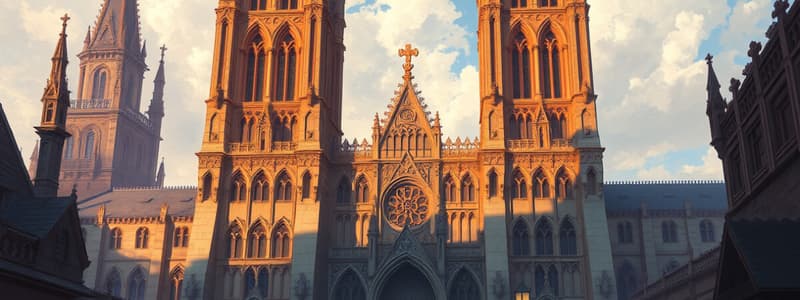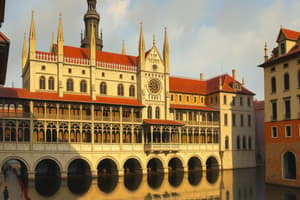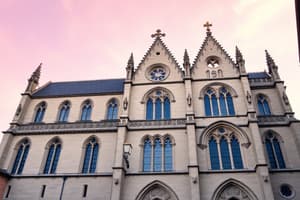Podcast
Questions and Answers
What was the primary role of churches during the Middle Ages in Europe?
What was the primary role of churches during the Middle Ages in Europe?
- To provide entertainment for the local populace.
- To act as a hub for religious and community life. (correct)
- To function as military fortifications against invasions.
- To serve as commercial centers for trade.
What shape were most church plans during the Norman architectural period?
What shape were most church plans during the Norman architectural period?
- Circular
- Square
- Octagonal
- Latin cross (correct)
Which of the following materials was NOT commonly used in Romanesque architecture?
Which of the following materials was NOT commonly used in Romanesque architecture?
- Concrete (correct)
- Brick
- Marble
- Terracotta
Under whose rule did the foundation of the church become a hub of religion?
Under whose rule did the foundation of the church become a hub of religion?
What are the characteristics of windows in Norman architecture in southern climates?
What are the characteristics of windows in Norman architecture in southern climates?
What distinguishes a crusade from a pilgrimage?
What distinguishes a crusade from a pilgrimage?
How did the socioeconomic structure change during the Middle Ages due to Christianity?
How did the socioeconomic structure change during the Middle Ages due to Christianity?
Which construction techniques were prominent in Romanesque architecture?
Which construction techniques were prominent in Romanesque architecture?
What role did the ruins of the Roman Empire play in Romanesque architecture?
What role did the ruins of the Roman Empire play in Romanesque architecture?
What architectural style emerged during Charlemagne's rule?
What architectural style emerged during Charlemagne's rule?
Which element characterizes the walls of buildings in Romanesque architecture?
Which element characterizes the walls of buildings in Romanesque architecture?
During which historical period did Norman architecture develop?
During which historical period did Norman architecture develop?
What impact did geography have on the evolution of Romanesque architecture?
What impact did geography have on the evolution of Romanesque architecture?
What is unique about the nave bays in the described architecture?
What is unique about the nave bays in the described architecture?
Which influence is evident in the exterior and certain interior areas of the church?
Which influence is evident in the exterior and certain interior areas of the church?
What type of vaulting is characteristic of the nave bays?
What type of vaulting is characteristic of the nave bays?
What characteristic is common among Romanesque churches in central Europe?
What characteristic is common among Romanesque churches in central Europe?
Which of the following describes a significant feature of Worms Cathedral?
Which of the following describes a significant feature of Worms Cathedral?
What is the primary purpose of a glacis in fortifications?
What is the primary purpose of a glacis in fortifications?
What feature is typical of the doorways in Romanesque architecture?
What feature is typical of the doorways in Romanesque architecture?
Which architectural feature is specifically designed to allow projectiles to be dropped on enemies?
Which architectural feature is specifically designed to allow projectiles to be dropped on enemies?
Which type of medieval domestic building typically housed both families and livestock?
Which type of medieval domestic building typically housed both families and livestock?
What architectural element converges at the top in a Helm Roof?
What architectural element converges at the top in a Helm Roof?
Which is the largest Romanesque church mentioned?
Which is the largest Romanesque church mentioned?
What distinguishes city houses and tower houses from other domestic buildings?
What distinguishes city houses and tower houses from other domestic buildings?
Which architectural element serves as a series of stout poles used for fortification?
Which architectural element serves as a series of stout poles used for fortification?
What is a characteristic feature of a town house in medieval architecture?
What is a characteristic feature of a town house in medieval architecture?
In fortifications, what is the function of a portcullis?
In fortifications, what is the function of a portcullis?
What architectural feature is described as having indentations and is part of a parapet?
What architectural feature is described as having indentations and is part of a parapet?
Which term describes a room or apartment located on an upper floor?
Which term describes a room or apartment located on an upper floor?
What is a characteristic feature of Stave Churches?
What is a characteristic feature of Stave Churches?
Which notable structure is NOT mentioned as an example of Romanesque architecture?
Which notable structure is NOT mentioned as an example of Romanesque architecture?
What type of building is referred to as a Ramloftstuga?
What type of building is referred to as a Ramloftstuga?
Which option best describes a cellar in architectural terms?
Which option best describes a cellar in architectural terms?
Flashcards are hidden until you start studying
Study Notes
Overview of Romanesque Architecture
- Developed between 800-1100 A.D., transitioning from Byzantine to Gothic architecture.
- Rooted in classical Roman architecture, incorporating Roman styles, techniques, and ornamentation.
- Characterized by regional variations despite a wide geographical spread across Europe.
Key Features
- Predominance of religious buildings, reflecting the spread of Christianity.
- Common church floor plans resemble a Latin cross shape.
- Norman Architecture in the north is synonymous with Romanesque.
- Utilization of local materials creates distinct regional architectural characters.
- Typical structural elements include round-headed arches, barrel vaults, and groin vaults.
- Buildings often feature thick walls and small openings for security and stability.
- Buttresses provide additional support to the structure's walls.
Influences on Development
- Geographical: Architecture evolved in areas influenced by the Roman Empire, spreading with Christianity.
- Geological: Initial use of materials from Roman ruins evolved into a reliance on local materials (stone, terracotta, wood).
- Climate: Architectural styles adapted to local climates, resulting in variations in window size and roof designs.
Socioeconomic Triggers
- Christianity: The collective effort to build churches unified communities, promoting Christian teachings and socio-economic changes in medieval Europe.
- Charlemagne's Influence: Under his rule, church foundations became societal centers, with artists recruited to enhance religious structures.
- Feudalism: The need for protection among feudal lords led to the development of military architecture alongside ecclesiastical structures.
Architectural Elements
- Fortifications include glacis, towers, parapets, battlements, machicolations, drawbridges, and portcullises.
- Domestic Architecture: Included long houses, city houses, and townhouses, often built using wooden or half-timbered construction.
- Notable domestic forms: Long Houses for families and livestock, Tower Houses with limited space, and modest Town Houses centered around squares.
Romanesque Characteristics
- Churches designed as Latin cross plans with nave bays and low side aisles.
- Incorporation of Moorish influences in tile design and architectural elements in some regions.
- Central European Romanesque architecture features octagonal plans and high structures, often lavishly decorated with carved figures.
Notable Examples
- Worms Cathedral, Germany: Apsidal plan with basilica and round towers.
- Speyer Cathedral, Germany: The largest Romanesque church, featuring a triple-aisled vaulted basilica.
- Other important structures include Durham Cathedral, Canterbury Cathedral, and Peterborough Cathedral.
Additional Architectural Types
- Cellar: Below ground storage area.
- Solar: Upper floor living space.
- Stave Church: Unique Scandinavian wooden churches utilizing vertical planks.
Conclusion
- Romanesque architecture serves as a significant transition period in the history of architecture, marked by its distinctive characteristics and socio-religious influences impacting the built environment of medieval Europe.
Studying That Suits You
Use AI to generate personalized quizzes and flashcards to suit your learning preferences.




